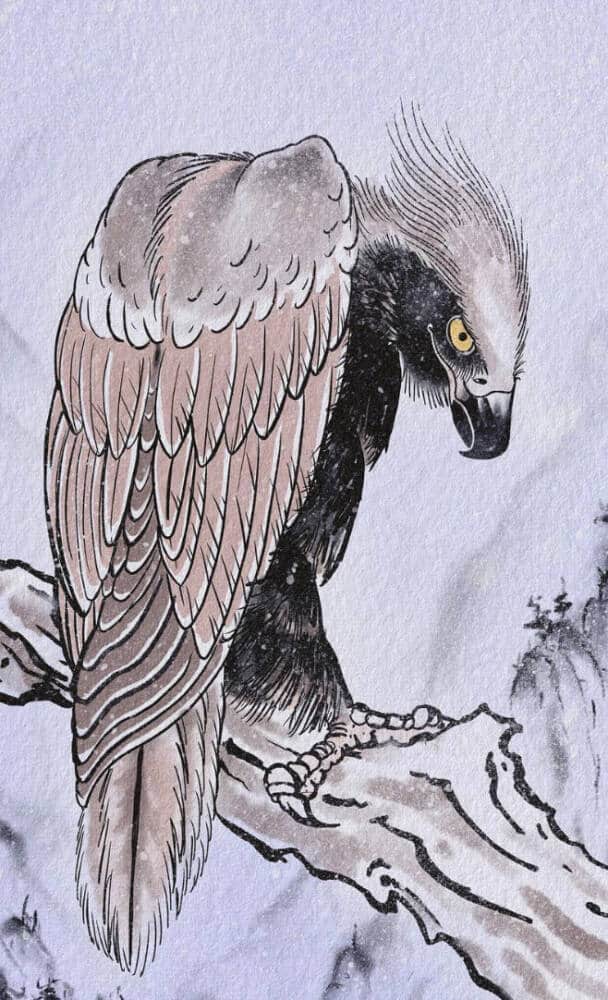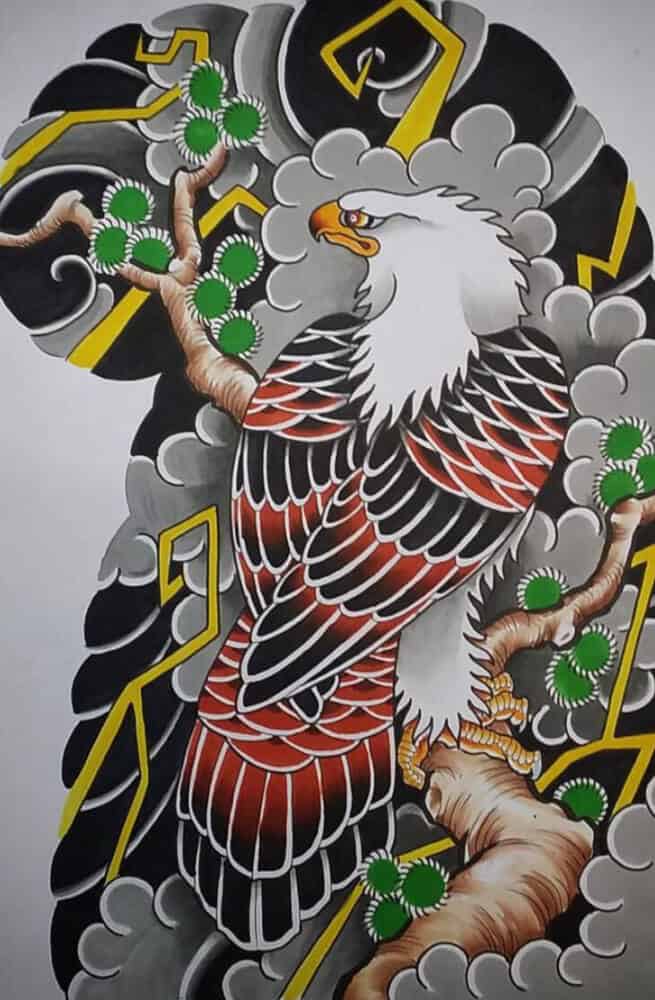Amenohiwashi-no-kami is a revered Eagle God in Japanese mythology. Appearing in both the archaic texts of Nihon Shoki and Kogo Shui, it has been a prominent figure in traditional tales and rituals since pre-historic times. Let’s find out the role of eagle in Japanese mythology.
For thousands of years, Amenohiwashi-no-kami has been a central figure in the sacred spiritual culture of Japan, not only possessing immense symbolic importance but being a celebrated being of mystic splendor.
The importance of the eagle in Japanese mythology is hard to overestimate - represented in the diverse figures of ancient gods and venerated in numerous rituals, the majestic eagle has been an iconic image in Japanese culture for centuries.
Understanding the details of Amenohiwashi-no-kami's past and present reveals a profound reverence for the vibrant eagle God and its spiritual guidance to the Japanese people.
Meaning Of Eagle in Japanese Mythology
Historical Origins of Amenohiwashi-no-kami
The historical origins of Amenohiwashi-no-Kami, the majestic eagle god of Japanese mythology, are deeply embedded in the collective consciousness of this remarkable culture.
One of the most celebrated texts associated with Amenohiwashi-no-Kami is the Nihon Shoki, a classic chronicle of Japan's earliest historical accounts.
An eagle god is mentioned in Japanese mythology as Amenohiwashi-no-kami in the Nihon Shoki and Kogo Shui (A historical text recorded by Inbe clan of Shinto practitioners in 807 AD).

He is given his name when, after Amaterasu has hidden in the cave of heaven, he plays a stringed instrument, and an eagle perches on the end of his strings.
He is also known as Amenohiwashi-no-mikoto and Amenokanatobi-no-mikoto. The bird has happily deemed a good omen, and he is given the name "Amenohiwashi-no-kami," with washi denoting an eagle in Japanese. Large birds like eagles and hawks probably held a particular place in our ancestors' hearts.
Ame-no-Minakanushi is a character of great importance in Japanese mythology, part of the Kojiki and Nihon Shoki works.
He is often referred to as the "Lord of the August Center of Heaven", and is thought to have been the first god to appear in the heavenly realm of Takamagahara.
According to the Kojiki, the primordial god of Japan emerged from the primeval chaos of heaven and earth at the beginning of the world. His name can be translated as "the Lord of the Sacred Center of Heaven".
He is also known as Zao Gongen, or the "Deified Primal Source", and has been represented in art and literature as a divine figure who plays a critical role in the Japanese creation story.
He commands the Five Deities who assist him in establishing order in the creation of the world, and holds authority over the Heavenly Kami.
Ame-no-Minakanushi is a benevolent god who stands for peace, harmony, and justice, and is usually portrayed with a kind and understanding demeanor.
He is the most important figure in Japanese mythology, and his place in it is celebrated in many places of worship throughout Japan.
Ame-no-Minakanushi is part of a pantheon of gods and goddesses that have been revered since ancient times.
Today, there are shrines honoring him, and festivals held in his honor. People have found inspiration in his wisdom and understanding, and continue to venerate him for his divine and helpful nature.
He is a beloved figure in Japanese culture, and his influence on religion and mythology is undeniable.
Role in Japanese Shintoism
The Kojiki and the Nihon Shoki portray Ame-no-Minakanushi as the first god to appear in the heavenly realm of Takamagahara following the emergence of heaven and earth from the primeval chaos. His creation story involves the defeat of various gods and demons to bring order to the chaos.
Ame-no-Minakanushi is tasked with containing and controlling the gods, demons and forces of the universe and thus, he is seen as the one responsible for maintaining balance and justice.
This makes him an important figure in Shintoism as his role is associated with the concept of justice and moral order.
In addition, his status as the oldest deity also makes him a revered figure in Shintoism. Ame-no-Minakanushi is worshiped by some as the center point of the deities and represents the traditional culture of Japan.
This reverence of him, in some respects, suggests him to be the source of all Shinto doctrine, as it's his rules that the others follow.
This veneration is seen in various shrines and ceremonies held in his honor, emphasizing the importance of respecting the divine and maintaining peace and justice in the world.
Role in Japanese Mythology
The eagle-god Amenohiwashi-no-kami is an important deity in Japanese mythology, with its appearances in both the Nihon Shoki and the Kogo Shui.
Commonly known as the sacred eagle of Japan, Amenohiwashi-no-kami is believed to be the symbol of strength and courage.

The eagle god appears in a variety of stories, showing the significance it held in a variety of contexts. In some of these stories, Amenohiwashi-no-kami appears as a protective deity, providing wisdom to those who seek guidance.
In certain legends, this deity was also depicted as an envoy of Heaven, mediating between the gods and mortals.
Throughout the ages, different ceremonies in honour of Ame-no-Minakanushi have taken place including seasonal festivals, dances and offerings.
These rituals were held for all sorts of occasions, with the intention of paying tribute to this majestic, primordial god.
Primarily, Ame-no-Minakanushi is seen as a deity that watches over the universe and safeguards the state of natural balance.
As time passes and various iterations of religions have appeared and survived, the age old devotion to Ame-no-Minakanushi remains strong to this day.
It is an important and integral part of Japanese religious life and culture, one that continuously acknowledges the influence of this primordial God.
In conclusion, Ame-no-Minakanushi is a very important god in Japanese mythology, often depicted as the Lord of the August Center of Heaven and believed to have emerged from the primeval chaos.
His character is featured in both the Kojiki and Nihon Shoki, making him a well-known figure in Japanese history.
He is an integral part of the ancient religions of Japan and his mythology is something that is studied by many today. In this way, he continues to have a lasting impact on Japanese culture.
Impact on Society
Since the earliest Japanese mythological texts, the eagle god Amenohiwashi-no-kami has featured prominently in Japanese mythology. This sacred bird, believed to represent justice and power, has had an indelible impact on Japanese society.
The Nihon Shoki and Kogo Shui are two major texts that depict the power of Amenohiwashi-no-kami, with stories painting the eagle as a source of wisdom and insight.
For centuries, Amenohiwashi-no-kami has been a symbol of spiritual and social importance.
This has been reflected in Japan’s art and culture, with the eagle often being depicted through traditional paintings and sculptures.
These depictions have played a key role in promoting the reverence and respect that is long-held for Amenohiwashi-no-kami and its associated mythology.
Today, the legacy of Amenohiwashi-no-kami continues to be felt throughout Japanese society. Many temples and shrines across the country are devoted to the eagle god, and it is seen as a symbol of protection and power.
Such is the importance attached to Amenohiwashi-no-kami, the name is often conjured when pledging loyalty and it is considered a symbol of strength and justice in society.
Clearly, Amenohiwashi-no-kami has had an extraordinary impact on Japanese society, from ancient times to the present day.
Events and festivals related to the eagle god are commonplace, such as the "Amenohiwashi-no-kami Festival" held in the Yatsushiro region of Kumamoto prefecture, and this reverence and respect shows no sign of fading.
Referencing in Popular Culture
The majestic symbol of Amenohiwashi-no-kami, the eagle god of Japanese mythology, can be found within many aspects of popular culture.
Since his first appearance in Nihon Shoki and Kogo Shui, this divine creature has become an iconic figure of reverence and eternity in Japanese belief systems.
As a popular motif of hero’s entering an arena, the eagle god is a symbol of the power of transformation and the bravery it takes to tackle difficult challenges.
From kabuki theatre to contemporary anime and manga, this symbol of power and courage has been explored and developed in a variety of contexts.
The fame of Amenohiwashi-no-kami has grown to a worldwide appreciation as a character seen in literature and visual arts.
Famous authors such as Nagai Kafu and Otomo Yoshihide have explored the meaning and significance of this spiritual figure in their works, while profound images of the god can be found in the paintings of Utagawa Kuniyoshi.
The meaning and message of Amenohiwashi-no-kami live on beyond the ancient texts and appears in today's pop culture.
From Tokusatsu live-action television shows to 'Tora-san' movies, the eagle god's spiritual as well as humorous representation in mass media continues to inspire many.
His philosophies of strength and self-determination continue to leave a lasting imprint in the hearts of the world.
In conclusion, the importance of the eagle in Japanese mythology is undeniable. God Amenohiwashi-no-kami is venerated as the guardian of the cosmic order and a source of wisdom. This deity and their majestic qualities were greatly respected and often appear in historical texts such as the Nihon Shoki and Kogo Shui. It is with awe and splendor that we revere the Sacred Eagle and the mystical lore that entices us from ancient centuries.
Also Read




